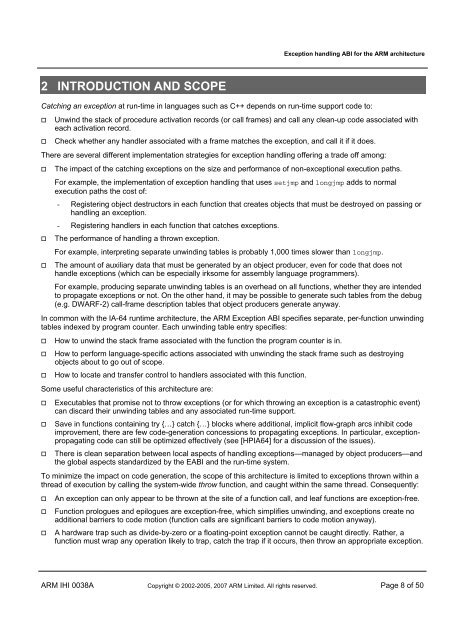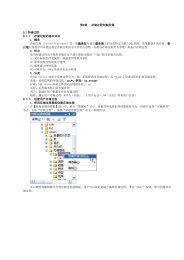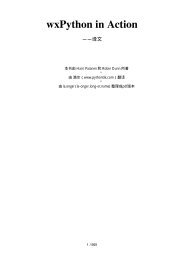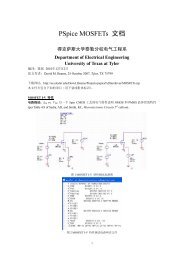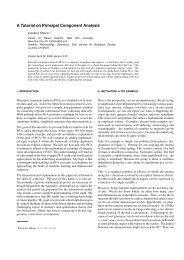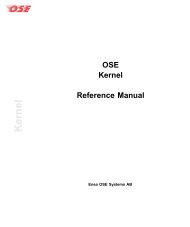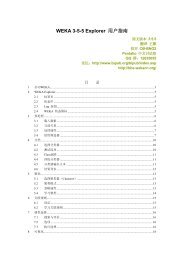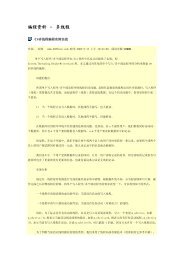Exception Handling ABI for the ARM Architecture
Exception Handling ABI for the ARM Architecture
Exception Handling ABI for the ARM Architecture
Create successful ePaper yourself
Turn your PDF publications into a flip-book with our unique Google optimized e-Paper software.
<strong>Exception</strong> handling <strong>ABI</strong> <strong>for</strong> <strong>the</strong> <strong>ARM</strong> architecture<br />
2 INTRODUCTION AND SCOPE<br />
Catching an exception at run-time in languages such as C++ depends on run-time support code to:<br />
<br />
<br />
Unwind <strong>the</strong> stack of procedure activation records (or call frames) and call any clean-up code associated with<br />
each activation record.<br />
Check whe<strong>the</strong>r any handler associated with a frame matches <strong>the</strong> exception, and call it if it does.<br />
There are several different implementation strategies <strong>for</strong> exception handling offering a trade off among:<br />
<br />
<br />
<br />
The impact of <strong>the</strong> catching exceptions on <strong>the</strong> size and per<strong>for</strong>mance of non-exceptional execution paths.<br />
For example, <strong>the</strong> implementation of exception handling that uses setjmp and longjmp adds to normal<br />
execution paths <strong>the</strong> cost of:<br />
- Registering object destructors in each function that creates objects that must be destroyed on passing or<br />
handling an exception.<br />
- Registering handlers in each function that catches exceptions.<br />
The per<strong>for</strong>mance of handling a thrown exception.<br />
For example, interpreting separate unwinding tables is probably 1,000 times slower than longjmp.<br />
The amount of auxiliary data that must be generated by an object producer, even <strong>for</strong> code that does not<br />
handle exceptions (which can be especially irksome <strong>for</strong> assembly language programmers).<br />
For example, producing separate unwinding tables is an overhead on all functions, whe<strong>the</strong>r <strong>the</strong>y are intended<br />
to propagate exceptions or not. On <strong>the</strong> o<strong>the</strong>r hand, it may be possible to generate such tables from <strong>the</strong> debug<br />
(e.g. DWARF-2) call-frame description tables that object producers generate anyway.<br />
In common with <strong>the</strong> IA-64 runtime architecture, <strong>the</strong> <strong>ARM</strong> <strong>Exception</strong> <strong>ABI</strong> specifies separate, per-function unwinding<br />
tables indexed by program counter. Each unwinding table entry specifies:<br />
<br />
<br />
<br />
How to unwind <strong>the</strong> stack frame associated with <strong>the</strong> function <strong>the</strong> program counter is in.<br />
How to per<strong>for</strong>m language-specific actions associated with unwinding <strong>the</strong> stack frame such as destroying<br />
objects about to go out of scope.<br />
How to locate and transfer control to handlers associated with this function.<br />
Some useful characteristics of this architecture are:<br />
<br />
<br />
<br />
Executables that promise not to throw exceptions (or <strong>for</strong> which throwing an exception is a catastrophic event)<br />
can discard <strong>the</strong>ir unwinding tables and any associated run-time support.<br />
Save in functions containing try {…} catch {…} blocks where additional, implicit flow-graph arcs inhibit code<br />
improvement, <strong>the</strong>re are few code-generation concessions to propagating exceptions. In particular, exceptionpropagating<br />
code can still be optimized effectively (see [HPIA64] <strong>for</strong> a discussion of <strong>the</strong> issues).<br />
There is clean separation between local aspects of handling exceptions—managed by object producers—and<br />
<strong>the</strong> global aspects standardized by <strong>the</strong> E<strong>ABI</strong> and <strong>the</strong> run-time system.<br />
To minimize <strong>the</strong> impact on code generation, <strong>the</strong> scope of this architecture is limited to exceptions thrown within a<br />
thread of execution by calling <strong>the</strong> system-wide throw function, and caught within <strong>the</strong> same thread. Consequently:<br />
<br />
<br />
<br />
An exception can only appear to be thrown at <strong>the</strong> site of a function call, and leaf functions are exception-free.<br />
Function prologues and epilogues are exception-free, which simplifies unwinding, and exceptions create no<br />
additional barriers to code motion (function calls are significant barriers to code motion anyway).<br />
A hardware trap such as divide-by-zero or a floating-point exception cannot be caught directly. Ra<strong>the</strong>r, a<br />
function must wrap any operation likely to trap, catch <strong>the</strong> trap if it occurs, <strong>the</strong>n throw an appropriate exception.<br />
<strong>ARM</strong> IHI 0038A Copyright © 2002-2005, 2007 <strong>ARM</strong> Limited. All rights reserved. Page 8 of 50


